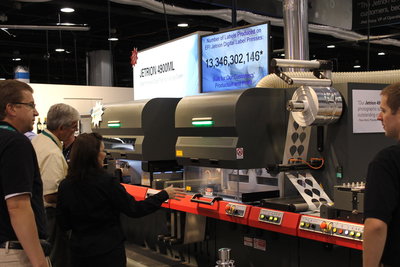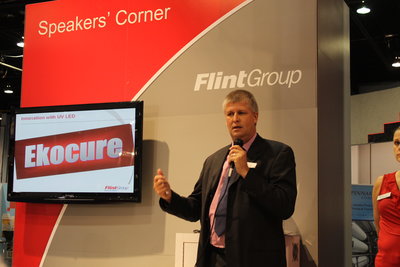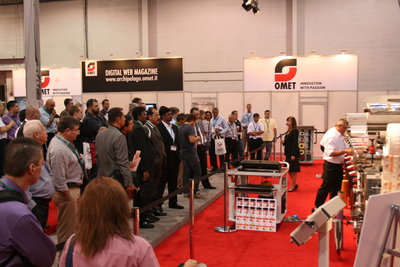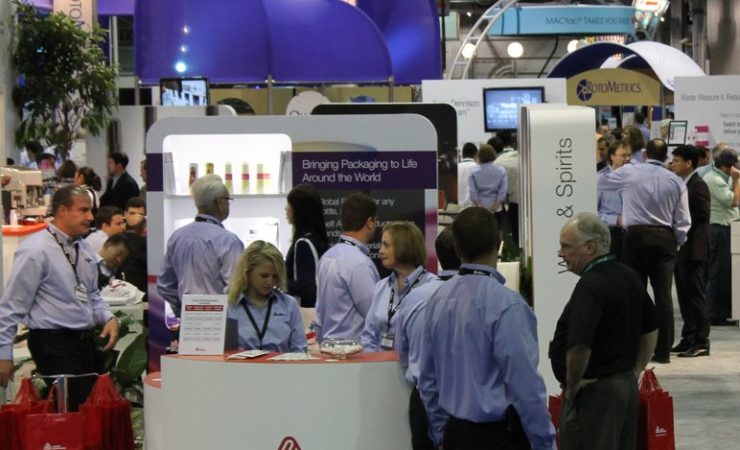With an increase in visitor numbers of more than 12%, Labelexpo Americas in Chicago was a great success, and unlike its European counterpart where digital has its own area, the US show saw flexo and digital mingling in the three halls. Neel Madsen crossed the pond to get the view from America.
There is no denying that there is a different pace to the American version of Labelexpo, but although it is smaller and shorter, there was a lot of energy and enthusiasm to be found at the 2012 show along with a whole host of new technologies and products.
The final tally showed that 14,335 visitors found their way to the Donald E Stephens Convention Center in Rosemont, half an hour’s drive from downtown Chicago. This represents an increase of more than 12%, encouraging news in these difficult times.
Over 100 new products were launched, and of the 400 exhibitors, 94 attended for the first time.
The package printing workshop had its US debut and showed live jobs run on a Xeikon 3500 with an X-800 digital front end, RotoMetrics dies and pre-press courtesy of Esko, while the laser die-cutting workshop ran a variety of labels to give the participating companies, AB Graphics, Delta Industrial, Sei Laser and Spartanics, a chance to show their individual strengths.
On show
AB Graphic International had two Digicon Series 2 on its stand with another running on the HP stand across the aisle, along with a Digicon Lite and other finishing equipment, including an HSR1700 inspection slitter/rewinder with Flytec. It also took part in the Laser Die-cutting Workshop pitching its technology against Delta Industrial, Sei Laser and Spartanics.
Apex Group of Companies brought its slalom ink channel GTT anilox technology along with the reduced-weight UltraCell series and the ReadyRoll advance in-stock roller program to the show under the slogan ‘Flexo Takes Flight’.
‘UltraCell anilox and GTT-Label arrive in the Americas at a unique point in flexo history,’ noted Apex Batistatos. ‘With higher quality plates, inks and presses, label printers are turning out amazing work. It’s truly a quality revolution. But what’s been missing – until now – was the anilox component that can deliver predictable, consistent ink release. Apex GTT-Label and UltraCell anilox rollers add the reliability and precision which this label revolution requires.’
Avery Dennison demonstrated a variety of new products including Shrink PS, a patent-pending, pressure-sensitive label for shrink wrap bags that delivers operational efficiency and crisp graphics and the TurnLock Laminating System, a durable film technology that combines facestock and overlaminate rolls resulting in material savings and resilient labels. It also introduced the Wash-Off label that cleanly curls and releases with no adhesive residue from a glass bottle in a warm caustic bath providing brands with the ability to meet aggressive recycling targets along with MultiCycle labels which allow for more than 30 cycles through the glass returnable system to deliver the impact of pressure-sensitive graphics at a lower cost and environmental impact.
Don Nolan, president, materials group, said, ‘We have heard very clearly from our customers and brand owners about the importance of innovations focused on improving sustainability. As a market leader, we have a responsibility to develop branding, packaging and supply chain solutions that contribute to a more sustainable planet.’
Berhalter presented the versatility of its die-cutting systems which allows both intricate lid and label geometries as well as a wide range of different materials to be processed and die-cut, including flat packaging lids out, recessed packaging lids, hygienic lids, in-mould and blown-mould labels, technical lids and paper- and light cardboard packaging labels.
Dantex exhibited for the first time with its new acquisition RBCOR, which was recently added to the group. On show was the company’s range of waterwash plates and processors including the new digital combination processor, DigiWash, with dual action wash and Digital VDU operator interface (see also News).
DuPont teamed up with Agfa Pitman to show ‘integrated, advanced, complete products and services that optimise tag and label print performance.’ On show was the new Cyrel Performance Series (DFP and DSP) digital plates, Cyrel DigiFlow workflow, Cyrel Fast and DuPont Tyvek. This was complemented by 3M mounting tapes, Toray letterpress plates, JM Heaford’s newly designed TT 500 ELS platemounter, the Epson SureColor S70670 64″ solvent printer and the WT7900 inkjet proofing system, X-Rite’s Exact handheld spectrophotometer, colour management and proofing applications from GMG, CDI Spark 2530, Apex anilox rollers and FlexoWash PW 45 WR plate cleaner.

EFI‘s strategy is to lead the printing industry’s transition from analog to digital by focusing on growth areas and helping customers add value. At the show, the Jetrion 4900ML UV digital inkjet printing system made its US debut and the 4900M-330 with a printing width of 13″ was shown for the first time worldwide. It also showed the Radius ERP software.
‘The high traffic around the brand new Jetrion 4900ML and 4900M-330 made it clear that the power of modularity is of interest to the label industry,’ said Sean Skelly, vice president and general manager of EFI Jetrion. ‘To date, there have been over 13 billion labels printed on Jetrion digital presses, which speaks to the production capability and industry leadership of the Jetrion brand, as well as the continued success of EFI customers. All of our digital label presses were running consistently throughout the show, and both current and potential customers were impressed by the recent advances in our technology.’
A joint venture between eltromat GmbH and Nyquist Systems GmbH saw the birth of new company Nyquist Technology, which will focus on developing economic alternatives to conventional print monitoring and print inspection systems.
The company presented the first cost-effective and user-friendly system for monitoring labels as an alternative to strobes and for missing label detection at the show. TubeScan combines imaging technology and the stroboscopic principle to provide two important functions achieving higher process safety. The ‘digital strobe web viewing’ function delivers a steady image and true colour fidelity regardless of the line speed, while the ‘missing label detection’ function detects the number of labels and remains of matrix across the entire web width.
‘With the new system, we will close the gap regarding quality control of flexible packaging and adhesive labels,’ said Dr Krebs, managing director of Nyquist. ‘We are confident that our systems will help the user in the market to significantly raise productivity while meeting quality standards,’ added Dr Kipp, managing director of eltromat.
Esko had a Kongsberg XN20 cutting table running and a Kongsberg i-XE10 Auto. It showed its latest technology updates, including PantoneLive support, new hybrid automated printing workflow and Suite 12, which includes WebCenter, Automation Engine, Color Engine, Studio and the version 12 editions of flagship editors ArtiosCAD, PackEdge, ArtPro and DeskPack.
The show saw the official launch of ETI Converting‘s Miniliner technology with demos every hour showing how to manufacture a pressure-sensitive label from raw material to the finished product on a 12 micron PET release liner using a conventional die-cutting method. The company said that based on the huge interest generated at show, it anticipates many sales of Cohesio machines equipped with this new technology in the coming months.

‘Take a ride on the time machine’, said Flint Group, encouraging visitors to take a trip through time to look at past innovations in narrow web printing. ‘We are really proud of our history and the achievements in our milestone innovations,’ said Niklas Olsson, global brand manager. ‘While we understand and fully appreciate that times are changing, we know that only through a continuous innovative mind set will you prevail. We think our history is strong evidence of the efforts we have made; we promise to never ever stand still on the journey ahead.’
The stand had a dedicated Speakers’ Corner where food packaging and labelling, Flint’s nyloflex NExT technology and UV LED (see below) were amongst the topics debated. This, combined with Happy Hour and daily prize draws along with the 8th Annual Narrow Web Awards, made for a buzzing stand.
Products featured included Flexicure Ancora UV low migration ink, new EkoCure UV LED inks for screen and flexo, and the new Flexo2Screen concept that can convert Flexocure Force UV flexo inks into UV rotary screen inks. This enables printers to reduce their ink inventory and create UV screen colours as needed.
Fujifilm had its Flenex DLE platesetter on display, a model D-25 which was due to go into a beta site after the show. The direct laser engraving processor is due to be commercially available by the end of the year. The company also launched its new water-based flexo inks and showed its Acuity LED 1600 wide format inkjet printer for labels and packaging.
Gallus joined forces with Heidelberg to demonstrate efficient integration of multiple printing technologies in a hybrid print shop environment to improve the success of its label printing customers.
Through live demonstrations, the company showed that the ideal shop consists of high performance flexo presses for short, medium and long runs, plus digital equipment for very short runs and variable imaging projects, and converting systems positioned either in-line or offline depending on the type of job being run. Each job is controlled by a management information system (MIS) that defines its path, then reports its performance at the end of the run. Featured equipment included the Gallus ECS 340 and ECS C presses, Heidelberg Linoprint L press and CERM business management and automation software.
GEW presented the new ‘energy2cure’ E2C system, which uses 42% less energy and permits full colour, process printing at full production speed with as little power as 90 W/cm. Lamp and reflector technology is designed to provide optimised cure on a wide range of inks including base white, screen, black and food compliant formulations.
The system is fully air cooled to safely handle the full range of label substrates, including very thin and heat sensitive materials without the need for expensive water installations. The addition of low maintenance design features to speed up lamp and part changeovers promises to reduce press downtime and the system uses 52% less air extraction, which creates a quieter working environment and reduces the running costs of plant heating and air conditioning.
Marketing manager, David Lyus, said, ‘With continuously increasing energy and consumables costs, more complex ink formulations and thinner substrates, spoilage is expensive. It is vital that we offer UV technology that will bring reductions in waste and production costs and a high level of confidence and security to customers using the product.’
Another company showing for the first time was GMG, which featured OpenColor, a spot colour tool for labels and packaging that extends colour control and repeatability, and GMG CoZone a comprehensive cloud solution for professional media and colour management users. In addition, advances and upgrades to the company’s pre-press portfolio, featuring products such as FlexoProof, ColorProof, ProductionSuite, ColorServer and InkOptimizer were showcased.
Harper Corporation showed the full capabilities of its technologies with a showpiece ceramic roller engraved with portraits of founders Ron and Katherine Harper. The company said that it experienced a large volume of visitors at its stand, which also featured a display of the Phantom QD ink proofing system. A second, smaller roller engraved with bold totem pole-like images highlighted LaserKote engravings, which are aimed for high volume printing.
IST Metz showed its MBS-6 system which is one of the main focal points of its ‘more3’ product line. Fitted with the company’s proprietory duo reflector technology, the UV curing system requires a lamp output of only 120 W/cm in order to achieve the same drying results as standard UV units which require up to 200 W/cm, and is, as Simon Mitchell, managing director at IST (UK) Ltd, said ‘the workhorse for the future’. He added that the company is not stopping at 120 W/cm but aiming to develop new systems using lamps requiring as little as 100 W/cm. Also on show was the new ELC Electronic Lamp Control, which has been specifically designed to operate UV lamps. Its integrated output controls guarantee a consistent output from the UV lamps.
To the dulcet tones of AC/DC’s ‘Thunderstruck’, Mark Andy launched its new Quick Change Die-Cut (QCDC) system shown on its Performance Series P7 press. The new system has a horizontal design and a completely enclosed shape. Dies slide sideways into the die-cutting station from a specially designed cart set at the same height at the press thus eliminating heavy lifting and cutting downtime by more than 80%. A P5 press was also running on stand and the company further introduced the new SRL 4.0 digital printer, which is based on OKI technology.
Martin Automatic was pleased with the attendance at the show and Gavin Rittmeyer, vice president of sales and marketing, said that they had seen more visitors and generated more leads than in 2010. On the stand was the newest versions of two of the company’s most popular machines, the MBS splicer and the LRD rewinder.
The company serves many different specialised industries and had a vast array of substrate samples on show. Its machine designs are based on a simplicity principle and spare parts can usually be source locally.
‘As the industry leader in roll change and web handling automation, we’re known for designing simplicity, reliability and the most appropriate advanced technology into our equipment,’ explained Mr Rittmeyer. ‘The new MBS splicer and LRD rewinder are examples of how Martin Automatic continues to develop and enhance products that give converters and printers the greatest versatility and value for their investment.’
MPS presented live demonstrations of its EF410 eight colour press showcasing automation on the press as well as pre-press and die-cutting automation. On the second day of the show, the company partnered with Kodak and Reproflex 3 for a live press demonstration of the power of spot colour reduction using Kodak’s Flexcel NX plates and Spotless Flexographic Solution. This saw three different jobs run on the EF410 press controlled via an iPad.
‘It’s time to think differently about flexo printing with only four colours,’ said Dr John Anderson, Kodak packaging segment director, Americas region. ‘A spotless workflow is finally here that allows you to ‘Do More with 4’ than you ever imagined, and it can revolutionise the way you plan daily production, bringing flexibility and significant cost benefits. Kodak’s revolutionary digital flexo plate technology brings outstanding consistency, predictability and quality to flexographic printing and provides the solid foundation upon which the ‘Do More with 4′ concept is built.’
Also on show was MPS’s new automatic plate mounter, APC-plate mounting. Demos showed how plates are mounted automatically on print cylinders or sleeves by using an optical measurement system and the company reports that it was very positively received by visitors.
Newfoil Machines demonstrated its new servo range of finishing machines, which include hot stamping, embossing, die-cutting and varnishing a pre-printed flexo web in register. The recently introduced SF330 servo flexographic coating and varnishing unit has been designed initially to coat and varnish webs from digital printing machines. It has been equally successful when used inline with the Newfoil hot foil range of machines. The machine features GEW UV and IR drying, and digital servo control systems with automatic register control. It can be configured as an infeed, finishing and rewinding machine or standalone machine as required.
Nilpeter introduced two new UV flexo presses, the FA-4* and the FB-3, and further demonstrated the latest four colour Caslon inkjet press, now available with a white or spot colour printhead. Also new was the FP-4 flatbed hot foil and embossing unit for increased finishing options.
The new presses were well received and the famous Nilpeter bell rang out 13 times at the show. ‘We successfully introduced our two new, innovative presses,’ said sales and marketing director, Jakob Landberg. ‘Visitors were impressed with the quick job changes from the printing units and die-cutting tools on both the FA-4* and FB-3. They also appreciated the latest ergonomic designs of the new presses, with their short web paths and overall user-friendliness.’
Nuova Gidue presented its Digital Flexo 3.0 technology incorporated into its M5 press. The 430 mm wide eight colour UV flexo press with three die-cutting units ran eight demonstrations a day with two format changeovers and a total waste for all three show days of between 10 and 15 metres.

With the aim of offering multi-process technology on one platform, Omet, which will be celebrating its 50th anniversary in 2013, introduced the new 530 mm wide XFlex X6 and showed two live jobs. The larger stand also included an XFlex X2 and an XFlex X4 press along with the new JetPlus digital technology first seen at drupa.
Rotoflex was showing a new design VSI slitter rewinder, a model that has been sold into more than 65 countries worldwide and described by Kevin Gourlay, business director, as the company’s ‘bread and butter’ machine. The company had a total of six machines running on a number of stands throughout the show. In the month leading up to the show, Rotoflex experienced record-breaking sales, which were enhanced with an additional 12 machines being sold at the show.
‘We could not be more proud of the performance of our Mark Andy and Rotoflex brands,’ stated CEO PJ Desai. ‘Our product development, engineering and support teams worked tirelessly to prepare for this event and the result has been outstanding.’
Along with the debut of the Accustar flexible die, RotoMetrics featured the Pin Eject Die, a technology offering a positive method of preventing build-up of small die cut slugs, designed for challenging cavity sizes as small as .0625 inches. The company said that the Pin Eject Die was very well received and quickly became one of the larger conversations circling the stand.
RotoMetrics’ vice president of technology, Steve Lee was the recipient of this year’s R. Stan Avery Lifetime Achievement Award which he collected to standing ovations at the Label Industry Global Awards on Tuesday September 11.
Screen USA was celebrating its 45th anniversary at the show and introduced the Truepress Jet L350UV press to the American market. Also featured was the PlateRite FX870II which outputs narrow web flexo digital plates, letterpress digital plates and thermal ablative film for the production of tags, labels, plastic bags and specialty materials.
Carlo Sammarco, Screen Europe, European business manager packaging solutions, said, ‘Labelexpo Americas allowed us to share digital printing and flexo platemaking solutions with scores of friends in the industry. The PlateRite FX870II high resolution imaging unit caught the attention of showgoers. The show also provided an excellent opportunity to assess the impact that integrating Equios Flexo series workflow products into your processes can have on the label printing market.’
SunJet, the global inkjet division of Sun Chemical and its parent company, DIC Corporation, launched EtiJet LM UV, its new low migration UV curing ink range for the digital label market. As well as showing its range of solutions for the narrow web market, which includes the Solaris system, Sun Chemical was a sponsor of the Ecovillage where its 2011 sustainability report was in the spotlight.
German die-cutting tool manufacturer Wink exhibited for the first time in Chicago. The focus of was on the company’s broad range of flexible die solutions, including four different non-stick coatings. The new ProMount system, which facilitates the positioning of flexible dies, saw its premiere to the American market.
Xeikon showed its 3300 digital press, patent pending X-800 Vectorizor software tool, Durable Clear Toner, VariLane software add-on, X-800 Digital Front End and presented the Xeikon Aura international network of partners. The show was also the first US outing for the new ThermoFlexx plate imager.
Michael V Ring, president of Xeikon America, Inc, said, ‘This year’s Labelexpo Americas gave us the perfect platform to further reinforce our leadership in the labels and packaging markets. We met many new converters and sold more than anticipated in both the North and South American markets.’
UV LED: The next big thing?
The working partnership of Mark Andy, Flint Group and Phoseon Technology showed its hand at Labelexpo Americas 2012 with the launch of ProLED, a new type of curing system that could change the face of UV in the printing industry.
Using solid-state semi conductors, the principle difference of the new UV LED technology over conventional mercury based lamps is that it uses medium wavelength UV, which avoids ozone and heat generation.
The partners claim that it offers advanced capabilities, with economy of operation and ‘green credentials’ that leave existing systems far behind. Operating at 16 W/cm2, the developers are predicting an ROI of less than 12 months, with a far higher level of press uptime than is currently possible. The drawback is that the system will not cure conventional UV inks and lacquers, so a range of EkoCure inks (F for Flexo, S for Screen) has been developed by Flint, with development underway for coatings, metallics, shrink whites and laminating adhesives.
Designed for use on flexible packaging and folding cartons, as well as labels and shrink sleeves, UV LED claims to consume 50% less power than existing systems. With maintenance also reduced (by up to 75%) due to the absence of blowers and ducting, and with no moving parts like mirrors and shutters, the whole system has a footprint half the size of existing UV setups.
According to Greg Palm, vice president of new business development, Mark Andy, ‘This technology will bring UV to new users because of its low cost and simplicity. For existing users, it offers a deeper and faster cure, but it also brings in those who are running water based inks.’ As evidence of the new technology’s reliability, Mr Palm added, ‘In the five year trial we ran, we didn’t have single LED failure!’
Chad Taggard, vice president of marketing at Phoseon Technology, added, ‘Working with leading printing press and ink manufacturers in the flexographic market has enabled Phoseon to build rugged products that provide superior performance and allow for easy integration into flexo presses. We feel the time is now for the market to rapidly adopt UV LED curing.’






